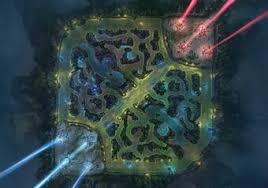League of Legends: Difference between revisions
From GameLabWiki
No edit summary |
No edit summary |
||
| Line 9: | Line 9: | ||
====Nexus, Towers, Minions and Monsters==== | ====Nexus, Towers, Minions and Monsters==== | ||
To win the game, the opponents ‚Nexus‘ must be destroyed. Deep in the center of a base it is protected by two heavy turrets, which have to be demolished first. The way to get there along the lanes is fortified with further turrets, three of which reinforce the entrances to a base and two more are positioned on each lane, to control a certain area and provide visibility and protection for the player´s champions. | |||
Further core elements on the map are the ‚minions‘ and ‘monsters‘. Minions spawning in ‚waves‘, | |||
==Research-Relevant Topics of the Game== | ==Research-Relevant Topics of the Game== | ||
Revision as of 15:14, 28 January 2020
About the Game
League of Legends is a Free-To-Play MOBA-type game available for PC. Published on 27 October 2009, the game of the american developer studio Riot Games has gained "a level of academic attention appropriate for its significance on both the eSports industry and the contemporary game culture." (p. 428) According to PC GAMER in a press release to the 10th anniversary in October 2019, League of legends reaches about 8 million player logins everyday and is therefore one of the most popular and relevant games throughout the gaming culture these days.[1]
Core Game Mechanics

Standart Game on ‚Summoner´s Rift‘
In a standard game, which usually lasts between 30 minutes and one hour, two teams composed of 5 players clash on the battle arena called ‚Summoner's Rift‘, each of them controlling one of 124 available champions. The Rift is a square area with a diagonal riverbed dividing the pitch into two halves. Those separated sections are in control of each team: In the bottom left corner lies the base with the so called ‚Spawnpoint‘ (starting point of the player´s champions) and the ‚Nexus‘ of the ‚blue‘ team. The upper right corner is the base location of the opposing team ‚red‘. As shown in the picture on the right, there are also the three lanes 'Top', 'Middle' and 'Bottom', which connect the team bases and by intersecting with the riverbed frame the four remaining zones: the so-called 'jungle'.
Nexus, Towers, Minions and Monsters
To win the game, the opponents ‚Nexus‘ must be destroyed. Deep in the center of a base it is protected by two heavy turrets, which have to be demolished first. The way to get there along the lanes is fortified with further turrets, three of which reinforce the entrances to a base and two more are positioned on each lane, to control a certain area and provide visibility and protection for the player´s champions.
Further core elements on the map are the ‚minions‘ and ‘monsters‘. Minions spawning in ‚waves‘,
Research-Relevant Topics of the Game
The three game-phases
Games can generally be divided into three ‘‘phases’’—laning, mid-game, and late-game. In the laning phase, players will focus on killing minions and monsters in order to gain gold so as to purchase or upgrade equipment. Top lane and mid lane will usually house one laner each, and bot lane will usually house two. Since champions from opposing teams share the lane while farming, skirmishes can often break out between players, although this depends on how willing they are to engage during this phase. It is common that one player will take on the role of ‚‘jungler’’—this player will not farm minions in lane but rather the monsters in the jungle, emerging into lane in order to kill an enemy laner if they have pushed away from the safety of their own defensive tower.
In the mid-game, champions roam the map and group in an attempt to kill large monsters, destroy towers, and pick off enemy champions who stray too far from safety. If one team is ‘‘snowballing’’ (gaining so much gold from killing enemy champions that they become exponentially effective at killing via the items they are able to afford), it is possible for them to win the game during this phase.
In the late game, most champions will be sufficiently geared and will be looking to kill all or most of the enemy team and subsequently destroy their nexus or, if this is not possible, destroy defensive structures or kill Baron Nashor (a powerful monster whose death confers significant stat boosts for the slayer’s entire team) if it is available. Once the nexus is destroyed, the game is over and players are placed into the postgame lobby where they can chat and view individual and team statistics. (p.430)
Mechanical Expertise and Metagame Expertise
significance of two types of expertise in the popular multiplayer video game League of Legends (p. 426)
players will always draw upon existing knowledge derived from previous play experiences or engagement with extrinsic resources (p. 427)
a player will likely not find success in the latter stages of the game unless he or she acquires some level of social expertise (p. 427)
‘‘mechanical exper tise’’—knowledge and mastery of the game mechanics -> substantial portion of the ‘‘forgiving early game content’’ (p. 427)
post-60 content, which requires large scale cooperation and coordination between players. (p. 427)
‘‘handling of the game,’’ which concerns the ‘‘physical and motorical’’ activities of gameplay & ‘‘meaning-making activities,’’ which involves his or her ‘‘understanding of the game in terms of how the game is to be played, their role in the game and the culture around the game.’’(p. 427)
Single player games typically do not require this form of expertise (p. 427)
Metagaming as ‘‘the relationship between the game and outside elements, including everything from player attitudes and play styles to social reputations and social contexts in which the game is played.’’ (p. 427)
